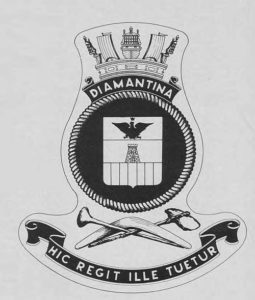- Author
- Ware, John
- Subjects
- None noted
- Tags
-
- RAN Ships
- None noted.
- Publication
- August 1972 edition of the Naval Historical Review (all rights reserved)
In May of this year the Minister for the Navy, the Honourable Dr. Malcolm MacKay, announced in Parliament that HMAS Diamantina may be presented to the Naval Historical Society of Australia when she pays off – probably in 1975. Mr. John Ware of the Naval Historical Section Melbourne, prepared this account of Diamantina’s interesting career.
DATA: Type: Oceanographic Research Ship (ex-Frigate). Displacement: 1,420 tons (standard). Length: 283 feet (between perpendiculars); 301 feet 4 inches (overall). Beam: 36 feet 9 inches. Builder: Walkers Ltd., Maryborough, Queensland. Laid Down: 12th April 1943. Launched: 6th April 1944 (Mrs. W.J.F. Riordan. wife of the then Chairman of Committees, House of Representatives and later Minister for the Navy). Armament: 2 x 40 mm Bofors AA. Commissioned: 27th April 1945.

Diamantina is one of twelve frigates built under the Commonwealth Government wartime shipbuilding programme. She was the sixth ship of her class to be completed. Sister ships were Barcoo, Barwon, Burdekin, Gascoyne, Lachlan, Hawkesbury, Macquarie, Condamine, Culgoa, Murchison and Shoalhaven. The last four named ships, while similar in design, were rated 1,544 tons (standard displacement) and were more heavily armed (4 x 4-inch guns; 3 x 40 mm AA; 4 x 20 mm AA as against Diamantina’s 2 x 4-inch guns and 2 x 40 mm Bofors AA). All were named after Australian rivers.
Diamantina takes her name from the river which rises in the region of the Kerby and McKinlay Ranges some 300 miles south of the Gulf of Carpentaria and flows in a southwesterly direction through Central Queensland. It is a seasonal river, dry for most of the year and only rarely flowing over the full length of its bed to the point of final dissipation in the region of Lake Eyre.
The Diamantina was discovered by John McKinlay, who was born at Sandbank, Scotland, in 1819, came to New South Wales in 1836 and later settled at Ki on the River Murray in South Australia. In 1861, at the request of the South Australian Government, he organised a party to search for the explorers Burke and Wills. Leaving Adelaide on 16th August 1861, McKinlay made his way to the Barcoo River (Coopers Creek) in the region of Lake Hope. He found no trace of Burke or Wills, but found the body of Gray, another member of the ill-fated Burke party. Returning south he halted at Lake Buchanan where he learnt of the finding of the bodies of Burke and Wills, but being well provisioned McKinlay decided to explore northwards.
He set out on 17th December 1861, but was forced to stop by lack of water at Lake Apanburra, west of Innamincka. On 10th February 1862 he set out again, and in March discovered the Diamantina, which he named Mueller River in honour of Dr. Ferdinand Von Mueller, the Victorian Government Botanist. On 6th May he reached the Leichhardt River and a fortnight later the Gulf of Carpentaria. Thence, after an unsuccessful attempt to reach the mouth of the Albert River (on the Gulf), he proceeded to the south-east through previously explored country to reach the settled areas of Queensland.
When McKinlay discovered the Diamantina, the State of Queensland had been in existence less than three years. It was formed on 6th June 1859 and its first Governor was Sir George Ferguson Bowen, who arrived in Brisbane to take up his appointment on 10th December 1859. Governor Bowen was born in Ireland on 2nd November 1821 and was trained for the law profession, but in 1847, at the age of twenty-six, he was made president of the University of Corfu, the northernmost island of the Greek Ionian Islands. In 1854 he was appointed Secretary of the Ionian Islands which were then (1815-64) a British Protectorate. During his sojourn in the Greek Islands, he met and married Diamantina, Countess Roma, daughter of the President of the Ionian Senate at Corfu (whose population was mainly Italian). In 1859 Bulwer Lytton (Colonial Secretary) appointed him first Governor of Queensland, and for the next twenty years he was entirely concerned with Australian and New Zealand affairs. In 1867, after eight years in Queensland, he succeeded Sir George Grey as Governor of New Zealand, and in 1872 became Governor of Victoria, retaining the post until 1879 when he was transferred to Mauritius.




